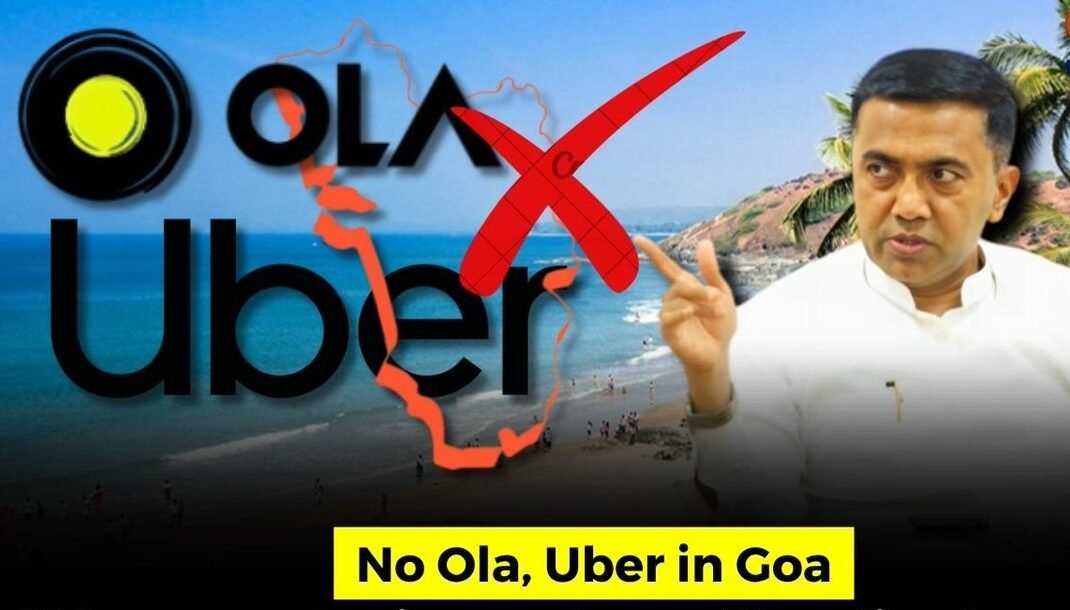Summary :
- CM Pramod Sawant confirms: “Ola and Uber are not coming to Goa.”
- Policy driven by coastal MLAs and taxi associations demanding fare control and local empowerment.
- State backs local digital apps like Goa Miles and Goa Taxi App.
- Tourists face mixed experiences; locals say digital integration improved livelihoods.
- A Calangute driver’s story reveals how grassroots tech adoption is changing lives.
In an age where ride-hailing apps have become synonymous with urban mobility, Goa is choosing to pause. Last week, Chief Minister Pramod Sawant confirmed what local whispers had long suggested: Ola and Uber will not be allowed to operate in the state—at least not yet.
The announcement followed growing pressure from coastal belt MLAs and taxi unions, who have long feared that Big Tech aggregators would threaten the livelihoods of Goa’s 12,000-strong taxi community. “We are not allowing Ola and Uber into Goa. Full stop,” Sawant stated, reinforcing that the transport aggregator guidelines released earlier are still under review.
For Goa, this isn’t just about transportation. It’s about who controls the economy of movement in one of India’s most tourism-dependent states—and whose voice gets heard in the process.
Local vs Global: What’s Driving the Resistance
At the heart of the resistance lies a simple truth: Goa’s taxi culture is deeply personal. Drivers don’t just transport; they often serve as informal tour guides, storytellers, and even translators. Coastal legislators like Michael Lobo argue that bringing in corporate cab operators could unravel this ecosystem.
“We’re not against change,” Lobo said. “But tourists must get fair, uniform fares. And drivers—who’ve lived here for generations—must not be replaced by outsiders or invisible algorithms.”
Instead of global apps, the state is promoting Goa Miles, a government-backed digital taxi aggregator that now covers over 4,000 drivers, and Goa Taxi App, which handles another 1,000. Together, these platforms already account for a third of Goa’s cab fleet.
The goal is simple: digitize without displacing.
Digitization on Local Terms
The shift to tech-enabled rides has not been without hiccups. Tourists frequently complain about limited availability, inconsistent app interfaces, and price surges during peak hours. Yet, for many local drivers, these platforms have meant greater dignity and stability.
Take the case of Ramesh Naik, a 42-year-old cabbie from Calangute. For over a decade, his livelihood depended on negotiating fares in broken English and hoping tourists wouldn’t cancel last minute. Since joining Goa Miles, he now receives 8 to 10 prepaid bookings daily—complete with digital receipts, GPS tracking, and customer ratings.
“I didn’t know how to use a smartphone properly before,” Ramesh admits with a smile. “Now I know when my ride is coming, who it is, and how much I’ll earn. I can even teach my son about apps now.”
Ramesh’s earnings have increased by 30%, allowing him to afford school fees and buy a second-hand scooter for his teenage daughter.
A Tourist Tradeoff?
Not everyone is cheering the decision. Many tourists feel stranded, especially those used to the convenience of tapping an app in Delhi or Mumbai. In the absence of Ola and Uber, first-time visitors to Goa often struggle to find cabs late at night or in rural beach zones, unless they prebook.
Hospitality groups have called for greater transparency, fleet expansion, and better training for app-based drivers to meet the volume Goa receives—especially during peak tourist season.
Yet the government appears unfazed. For now, it is betting that empowering local entrepreneurs is worth the occasional inconvenience. Goa’s tourism department has even partnered with Goa Miles to run awareness programs for drivers on digital etiquette and tourist safety.
Conclusion: A Kulhad-Sized Rejection of Silicon Valley’s Pitch
Goa’s rejection of Uber and Ola isn’t just policy—it’s philosophy. It’s a reminder that “disruption” doesn’t have to mean displacement, and that modernization can be shaped by local values—not just market forces.
By choosing to build up homegrown platforms rather than hand over the steering wheel to global giants, Goa is experimenting with a rare, people-first model of tech adoption. Whether this model can scale—or sustain under mounting tourist pressure—remains to be seen.
But for drivers like Ramesh Naik, it has already changed everything. “I may not wear a uniform or speak English fluently,” he says, “but now I feel like a professional. Like I belong in this new Goa.”



